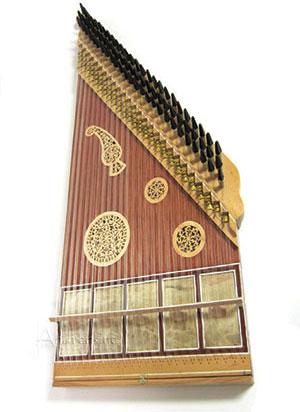Cool Stuff: Arabic and Indian Music
Hello everyone, I hope y'all doing great!. This week in class we have been focusing on Arabic and Indian Music. I have always been fascinated by Arabic and Indian in general, but I never look at it more in-depth. I wasn't sure how to start, but I figured it out. So, today I will be talking about Arabic music, traditional instruments used in Arabic music, and the different dances. Please set back and enjoy it.
Arabic Music
Maqam System
The maqam system is a theory of Arabic music that goes back to the ninth century. Arabic music is based on 8 commonly used melodic models or maqams. This system is composed and improvised, weather vocal, and instrumental. It is mostly taught orally, and by listening to traditional playing. It is also to create a mood or motion for the listeners.
These particular tones are organized in seven tone scales, and each one has a characteristic musical phrase made up of four continuous tones. That gives the maqam the flavor and recognizability it has. The tuning contains tones that sound "out of tune". It is called "microtones," because their distance apart is less than that of the semitone. To create Arabic music one should play traditional instruments that can produce the microtones that a non-native instrument can not.
Melodic Style
Traditional Arabic music is wholly melodic. It is often melismatic and highly ornamented. The singing is held as an expressiveness in music. In traditional styles, singers are always accompanied by an instrument that plays in unison with the singer.
Rhythm in Arabic Music
The rhythm is often a free rhythm, Metric rhythm is organized by rhythmic patterns that go like - 3, 4, 7, 8, or 10 beats long, it can go more than 100. The pattern is made up of two different timbers. The first is low-pitched and the other one is higher and drier. In the article, the author stated that "these patterns can be varied by decoration in performance, similar to improvised melodic ornamentation."
Traditional Instruments in Arabic Music
 |
| Alto Kemancha |
 |
Dabke an Arabic Fold Dance
The Dabke is an Arabic dance that started in the mountains. More specifically above the Mediterranean coastline and the Tigris River. When the dance was created only people from the villages and towns of Lebanon, Syria, Palestine, Jordan, Iraq, and some other regions nearby danced to it.
Today I want to focus more on Lebanon where it was originally formed. So back then when the weather would change, the villagers had to adjust one way or another. They did this by forming a dance based on building their homes. In Lebanon, and other regions would dance on top of the roofs because their roofs were flat and made of tree branches topped with mud. The reason they did this is that the weather would change the mud, which resulted in cracks on the roof. So, when they fix the roofs that would hold hands, form a line, and start stomping their feet while walking off the roof so that the mud would adjust. It was also great because the men had to work in the cold weather so the dance would help them keep warm.
This lead this tradition to be passed down to close family and people in the villages. The lyrics were sung while they danced while helping each other fix cracks their roofs were also passed down. Nowadays the Dabke is danced at a wedding, special occasions, and family gathers. At first, the dancing was slow but when the dance progressed it became fast.
Unfortunately, I wasn't able to find a video where they dance on the rooftop but enjoy the video I add to the blog!


Sources:
“TRADITIONAL MUSIC IN THE ARAB WORLD.” Music in Global America, scalar.usc.edu/works/music-in-global-america/traditional-music-in-the-arab-world.
Metmuseum.org, www.metmuseum.org/blogs/metkids/2019/meet-musical-instruments-galleries-families.
Collaborator, Areviews App. “What Is Kamancheh?” Sala Muzik, Sala Muzik, 30 Mar. 2020, salamuzik.com/blogs/news/what-is-kamancheh.
Farraj, Johnny. The Qanun, www.maqamworld.com/en/instr/qanun.php.
Introtodance. “The Dabke-An Arabic Folk Dance.” History and Development of Dance/ Brockport, 9 May 2013, dancehistorydevelopment.wordpress.com/2013/05/09/the-dabke-an-arabic-folk-dance/.
“TRADITIONAL MUSIC IN THE ARAB WORLD.” Music in Global America, scalar.usc.edu/works/music-in-global-america/traditional-music-in-the-arab-world.
Metmuseum.org, www.metmuseum.org/blogs/metkids/2019/meet-musical-instruments-galleries-families.
Collaborator, Areviews App. “What Is Kamancheh?” Sala Muzik, Sala Muzik, 30 Mar. 2020, salamuzik.com/blogs/news/what-is-kamancheh.
Farraj, Johnny. The Qanun, www.maqamworld.com/en/instr/qanun.php.
Introtodance. “The Dabke-An Arabic Folk Dance.” History and Development of Dance/ Brockport, 9 May 2013, dancehistorydevelopment.wordpress.com/2013/05/09/the-dabke-an-arabic-folk-dance/.
I really enjoyed reading your blog, my favorite part/instrument mentioned would have to be the qanun. Its my favorite because of the description of the instrument that you gave. The meaning behind the name is very interesting to me. "laying down the law" for the rest of the instruments. Very interesting.
ReplyDeleteI loved your blog Christina, it really caught my attention. The thing that really caught my attention was the instrument you mentioned, the qanun. I find it really neat how one instrument can lay down the law of pitch for other instruments.
ReplyDeleteI loved reading through your blog! I thought it was really interesting how the lyrics of the fold dance were sung while people fixed their roofs and it was passed down from generation to generation. Also the part about now the qanun can lay down the "law" for the other instruments in a piece was pretty cool.
ReplyDelete